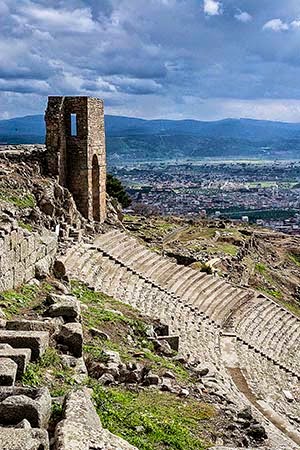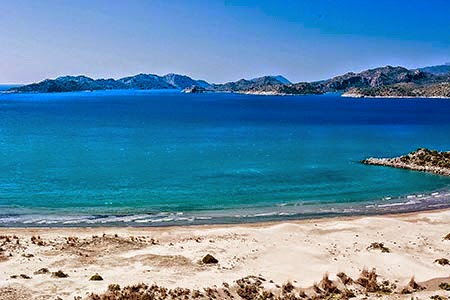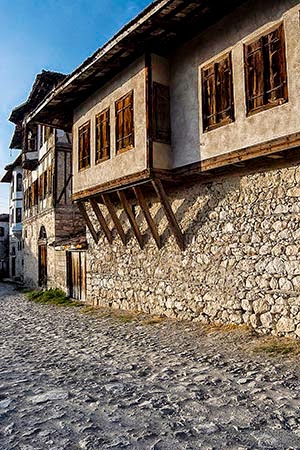How is Priene connected to Architecture?
 |
| Temple of Athena holds up Mt. Mycale |
Is Priene this worth visiting? Well, it is if you want to learn about its connection to the Acropolis in Athens or indeed all classical architecture. Priene also has a beautiful setting.
 |
| All the way to the mountains used to be the Aegean Sea |
Click on one of the Priene photos once to see a larger view in a slide show.
Priene has a beautiful setting on a hill overlooking the cotton fields. All those fields below the hill were once the Aegean Sea!
The valley was filled in by the ever-shifting Menderes River from which our word meander is derived. The Romans had to abandon this site because the harbour had silted up. The sea is now 6 km away and, as shown in this map, the bay became a lake – Bafa Golu!!!
 |
| Your own private theatre |
Theatre of Priene
The small but well-preserved theatre was delightful. It has five armchair seats, with lion paws on each side. Originally built in the 4th century BC by the Greeks, the Priene theatre was expanded by the Romans in the 2nd century CE to hold 6,000 spectators.
The small but well-preserved theatre was delightful. It has five armchair seats, with lion paws on each side. Originally built in the 4th century BC by the Greeks, the Priene theatre was expanded by the Romans in the 2nd century CE to hold 6,000 spectators.
 |
| Your own private chair |
Temple of Athena Polias
Priene’s main temple, Athena Polias, was dedicated in 334 BC by Alexander the Great, who stayed here during his lengthy siege of Miletus. It was designed by Pytheos, the architect of Halicarnassus, one of the Seven Wonders of the World, and located in today’s city of Bodrum in Turkey. The statue inside was a copy of the famous Athena of Phidias in the Athenian Parthenon. No that’s not the connection I mentioned before.
 |
| Priene used to be Ionian Greece |
Ionic Order of Classical Architecture
 |
| Temple of Athena Nike on the Athens Acropolis |
The Ionic capital is characterized by the use of volutes (spiral scrolls) on top of a fluted shaft. The cap is usually carved with the egg-and-dart pattern. Vitruvius – a very famous architect during the time of Augustus and author of the book De Architectura – describes the Ionic order as showing “more graceful” female body proportions. Did I mention how important Vitruvius was? He in turn influenced future architecture. It was the re-discovery and application of his book by Brunelleschi (c. 1402) that led to the Renaissance of architecture and the Duomo of Florence.








No comments:
Post a Comment
Please add your comments or questions